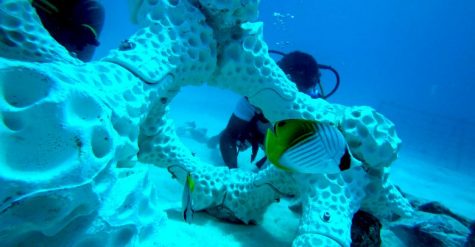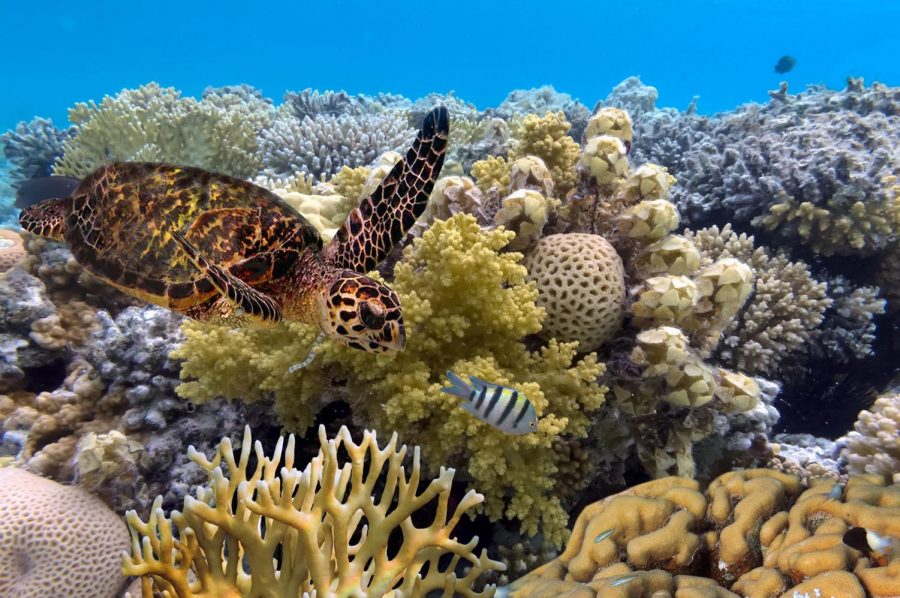3-D Printed Coral Reefs
National Geographic www.nationalgeographic.org/article/great-barrier-reef/
Coral reefs provide many benefits to both marine animals and people, but they are disappearing quickly.
May 31, 2020
Over the past century humans have rapidly and immensely industrialized and developed their society; however, this industrialization has also been damaging to our environment. Many different habitats on earth are becoming increasingly smaller such as prairies, wetlands, and coral reefs. All of these environments provide various ecosystem services such as protection, filtration, and a habitat for many different species of animals. Coral Reefs have been declining in the past decades and are in danger from environmental factors as well as human factors, but scientists may have found a new way to help keep coral habitats alive and healthy: 3-D printing.
Coral reefs provide numerous benefits to countries and are an essential habitat for many fish and shark species. Coral reefs protect coastlines of cities from waves and tropical storms as well as aid in nutrient cycling. In addition to these benefits coral reefs provide resources, such as food, to numerous countries and hundreds of millions of people. Despite these immense benefits coral reefs only exist in less than one percent of our oceans. Even with small coverage coral reefs are still home to over twenty-five percent of marine species. Coral reefs provide vital habitats and resources to our world, but sadly they are in danger.
Coral reefs are threatened by a number of natural causes; however, they continue to be further threatened by human activities. When people start to build cities they take out trees and cover the soil with concrete, this leads to increased erosion and run-off in cities. This run-off picks up pollutants, sediments and other various materials on its way to the ocean. When it reaches the ocean sediments block oxygen necessary to coral, and plastics increase disease vulnerability of coral reefs. Warmer ocean temperatures also contribute to the destruction of coral reefs. The weather pattern El Niño causes a heating of the oceans for several months at a time and occurs every two to seven years. When coral reefs become too warm they begin bleaching, which can be deadly to reefs. El Niño has led to coral damage by bleaching; however, increased ocean temperatures over the past century have exacerbated these conditions. Many coral reefs are now becoming bleached and do not have a chance to recover properly. All of these factors come together to cause great destruction of our coral reefs and many of them are beyond repair.
Scientists have recently discovered the possibility of 3-D printing coral as a way to save our earth’s coral reefs. 3-D printing would provide a way for coral reefs to build themselves back up after being flattened in a weather event by supplementing an existing coral reef with 3-D printed coral. Scientists wondered how to make this coral environmentally friendly and discovered they were able to use materials such as biodegradable cornstarch to build their coral. In addition, scientists also researched how this 3-D printed coral would be accepted by fish that live in the coral reefs and coral polyps. Scientists tested blue-green damsel fish and mustard hill corals to see if they would receive the 3-D printed coral even with natural coral present. These fish and coral polyps remarkably showed no preference in utilizing the printed versus natural coral. This gave hope to scientists that 3-D printed coral could benefit destroyed coral reefs because the fish and coral are similar to many other species that live in coral reefs. Furthermore, Scientists can make this coral at low costs and fairly easily using photos from different angles of the coral. This efficiency, combined with the findings from their research provides scientists with encouragement that 3-D printed coral could one day provide the aid our coral reefs are in desperate need of. Ultimately, 3-D printing provides a new method to help save our coral reefs and their benefits from the growing dangers of pollution and bleaching.

Sources:
Cho, Renee, et al. “Losing Our Coral Reefs.” State of the Planet, 9 Dec. 2019, blogs.ei.columbia.edu/2011/06/13/losing-our-coral-reefs/.
“Importance of Coral Reefs – Biodiscovery and the Great …” Queensland Museum, www.qm.qld.gov.au/microsites/biodiscovery/05human-impact/importance-of-coral-reefs.html.
University of Delaware. “3-D printed coral could help endangered reefs: Researchers find fish give ‘fins up’ to printed coral models.” ScienceDaily. ScienceDaily, 16 October 2019. <www.sciencedaily.com/releases/2019/10/191016124633.htm>.
“World’s largest 3D printed coral reef installed at Maldives island resort.” 3D Printing Media Network, 17 Aug. 2018. www.3dprintingmedia.network/largest-3d-printed-coral-reef-maldives/. Image.
VLAD61. “Barrier Reef.” National Geographic, 19 Apr. 2019. www.nationalgeographic.org/article/great-barrier-reef/. Image.



